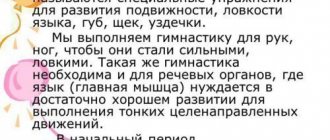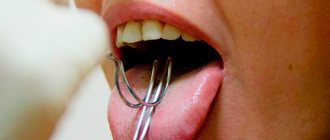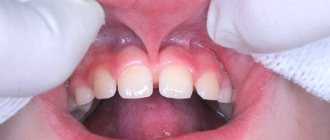Problem: for a consultation with the Dial-Dent speech therapist T.B. Zukor was contacted by a 22-year-old man. His wish: “We urgently need to trim the frenulum of the tongue! The surgeon needs a referral from a speech therapist to perform the operation!” The reason for this urgent treatment was unbearable pain in the tongue area when kissing!
Solution: myofunctional examination confirmed the need for frenuloplasty of the tongue (surgery to trim the frenulum of the tongue). The man received a referral for an operation, which was performed by surgeons at the clinic. Frenuloplasty of the tongue was successful, the pain was completely eliminated.
The speech therapist of the Family Dental T.B. talks about the short frenulum of the tongue, how to identify it, and what to do with it. Zukor in his article.
Short frenulum of the tongue - how to determine?
Symptoms of a tongue frenulum are usually identified by a speech therapist during a myofunctional examination. Most often, specialists (this can be attentive parents or the patient himself) observe the following symptoms:
- Limitation of tongue mobility; it is difficult for the patient to move the tongue out of the mouth and raise the tip of the tongue to the upper lip.
- The tip of the tongue bifurcates when you try to push it forward.
- The patient pronounces the sound L incorrectly, making it sound like V.
- Sometimes a short frenulum of the tongue brings purely everyday discomfort, as in the clinical case described above.
What is it and why do we need it?
Such anatomical formations are the thinnest folds of the mucous membrane that connect the mobile lips and tongue with the fixed parts of the oral cavity: the gums and the sublingual space.
In total, there are three frenulums in the baby’s mouth:
- Tongue - located under the tongue.
- Upper lip - localized between the upper lip and the gum mucosa above the level of the central incisors.
- Lower lip - connects the inner surface of the lower lip with the gums at the level of the middle of the alveolar process on the lower jaw.
Despite their small size, such mucous folds are of great importance in human life. In a newborn, they are responsible for proper attachment to the mother's nipple. In older children, the frenulum is involved in the correct pronunciation of sounds and in the formation of a normal bite.
Methods for eliminating a short frenulum of the tongue
A short frenulum of the tongue is corrected surgically. The most modern method is cutting the frenulum of the tongue with a laser, since there is less pain, the operation is almost bloodless, the wound is sterile and heals quickly.
Operations can be different:
- Frenuloplasty of the tongue is plastic surgery of the frenulum of the tongue with mobilization. Mobilization is the preparation of the edges of the wound for a screed by pulling the tongue forward and upward; flap formation is often used in plastic surgery. In most cases, frenuloplasty of the tongue is the most favorable way to lengthen the frenulum for both healing and restoration of the tongue.
- Frenulotomy is a dissection of the frenulum, usually done in the maternity hospital by simply cutting the frenulum without sutures.
- Frenulectomy - excision of the frenulum. During this operation, the doctor cuts the tissue wedge-shaped in several places, then applies sutures, but does not mobilize the tongue. This is a disadvantage of the method.
Obviously, each case is individual and the choice of method should be made by a specialist.
How to check a child's frenulum?
A shortened frenulum between the lip and gum is diagnosed quite simply even in infants. To do this, you need to carefully pull back the child’s lips and see how pronounced the fold of the mucous membrane is and where it is attached. If it is short, then it will have a thick appearance and its attachment point will be at the very base of the incisors.
The hyoid frenulum normally has a length of at least 8 mm and is attached approximately halfway between the root and tip of the tongue. A small frenulum usually looks like a fold on the mucous membrane, attached along its entire length to the tongue or sublingual space.
How to stretch
It is necessary to immediately make a reservation that, due to anatomical features, only the frenulum under the tongue can be stretched without surgery. This technique is usually taught by a speech therapist and is effective only if all recommendations are carefully followed over the course of several months.
Before performing any exercises, it is recommended to do a special massage to stretch the soft tissues. To do this, you need to carefully take your tongue by the very tip and with gentle movements move it upward, then to the sides and pull it forward a little. Gentle stroking from bottom to top along the frenulum using the thumb and index finger has a good effect.
The exercises themselves are performed sequentially twice a day:
- Relax your tongue as much as possible and place it on your lower lip. Hold for 10 seconds in 3 sets.
- Stick your tongue out of your mouth as far as possible. Fix in this position for 10 seconds. Repeat 3 times.
- Extend your tongue and circle your lips with it.
- Click your tongue for 10 seconds, imitating the clatter of horse hooves.
- Open your mouth wide. Slowly run the tip of your tongue across the roof of your mouth, moving from your teeth to your throat.
- Place your tongue on the roof of your mouth just behind your teeth. Holding it in this position, open your mouth as wide as possible.
Such fairly simple exercises help both stretch the frenulum on the tongue and correct some speech defects.
Short hyoid frenulum
- Speech therapist.No
- Consultations
- Short hyoid frenulum
During the consultation, you were told that the child has a short hyoid frenulum and in the future it will most likely need to be trimmed. What to do?
Hyoid frenulum
The sublingual frenulum is a membrane that is located under the tongue and connects the tongue to the sublingual space.
How to determine whether the hyoid frenulum is long enough?
Indeed, in different people the hyoid ligament (frenulum) can be of different lengths. If a child can stick his tongue out of his mouth and at the same time its tip does not bifurcate in the shape of two semicircular petals due to the fact that the hyoid ligament pulls it from below, if he can lick the saucer and click his tongue, then he will most likely have no obstacles for making sounds that require raising the tongue to the palate.
In a 5-year-old child, the frenulum in a stretched state should be at least 8 mm.
Short hyoid frenulum
A short hyoid ligament (frenulum) is a congenital defect consisting of shortening of the lingual frenulum (hyoid ligament).
What does this mean?
Short hyoid frenulum:
- may cause difficulty in tongue movements, because does not give him the opportunity to rise high. In this case, the so-called “upper sounds” suffer, i.e. the pronunciation of sounds such as Ш, Ж, Ш, ШЧ, Р, Рь is impaired
- can lead to a displacement of the center of the tongue, its asymmetrical development and low mobility, which prevents the formation of the correct articulatory posture of some sounds.
- may also be the cause of a violation of diction (Diction is clarity, intelligibility of pronunciation)
- in some cases, it can provoke problems with the formation of the lower jaw, i.e. The teeth may deviate and the necks of the teeth may become exposed. There is a risk of developing periodontitis and gingivitis. Therefore, a consultation with an orthodontist is necessary.
What to do?
There are two options to solve the problem:
- Stretching the hyoid frenulum
- Surgery
Stretching the hyoid frenulum
- This is reasonable if the frenulum is not very short, otherwise stretching a very short frenulum, according to some doctors, can lead to sagging of the mucous membrane, etc. the problems described above (periodontitis, gingivitis).
- Stretching is most successful up to 5 years of age. And the older the child, the more difficult it is.
- Stretching does not cause as much stress to the child as surgery, but it takes significantly more time and effort. After all, the corresponding exercises need to be performed several times a day, every day, and on a positive wave.
- Stretching with the help of speech therapy massage is an unpleasant process, often very painful for the child.
- Surgery is often easier for some parents.
Even if the frenulum is somewhat shortened (equal to 8 mm), it is better to stretch it than to operate
Many exercises can be started from a very early age. Remember! The baby will not be able to sit with you in front of the mirror and do the exercises according to your instructions. Turn everything into a game.
Exercises for the little ones
1) Lick the saucer. Invite your child to lick the saucer like a kitten.
2) Reach with your tongue for the spoon 3) Reach with your tongue to your chin 4) Reach with your tongue to your nose 5) Swing open your mouth, with the tip of your tongue reach first to the nose, and then to the chin, then again to the nose, and then again to the chin. 6) The horse smile, open his mouth. Click the tip of your tongue like a horse clicking. The mouth is open, the tongue should be wide. Make sure that the tip of the tongue does not turn inward, and that the lower jaw remains motionless. You can sit on a toy horse (if there is one in the house), or you can sit on your mother’s lap.
Exercises for older children
Along with the previous ones, you can do the following exercises:
1) Delicious jam: open your mouth slightly, the tongue moves along the upper lip from top to bottom, but not from side to side (as if licking the jam). The lower jaw should be motionless. 2) The painter invite the child to use his tongue, like a “brush,” to paint the ceiling in the “house” - the mouth. To do this, you need to open your mouth and stroke the palate with the wide tip of your tongue, making movements back and forth (from the teeth deep into the oral cavity and back). 3) Drum Show your child how to imitate a drum by beating a beat with your tongue. To do this, you need to open your mouth, smile slightly and, with the tense tip of your tongue, tap on the alveoli (tubercles behind the upper incisors), repeatedly and clearly, in one breath, pronouncing the sounds “D-D-D.” Tap slowly at first and then increase the tempo. Ask the child to repeat. Make sure that the child does not close his mouth during the exercise. 4) The fungus opens its mouth wide, presses the wide flat of the tongue against the palate and sucks it. Hold your tongue in this position for 5-10 seconds. The tongue will resemble the cap of a fungus, and the stretched hyoid ligament will resemble its thin leg. Then, “unstick” your tongue and close your mouth. Repeat the exercise 2-3 times. 5) Accordion Show your child how to draw an accordion using your tongue. To do this, you need to suck the wide tip of your tongue to the roof of your mouth, as in the “Mushroom” exercise, and then, without peeling off your tongue, open and close your mouth. The hyoid ligament (frenulum) will act as an accordion, which either stretches to its full length, then contracts.
Remember!
- Exercises must be performed systematically, gradually increasing the time they are performed (the number of repetitions of each exercise), only then will the desired effect be achieved.
- The sooner you start classes with your child, the faster you will achieve the desired result.
- The older the child, the more difficult it is to stretch the hyoid frenulum (targeted stretching of the hyoid frenulum using speech therapy massage is an unpleasant procedure, quite painful for the child). Stretching is most successful up to 5 years.
Surgery
Surgery is always stressful for a child
- You need a good doctor and modern equipment. Good reviews about the consequences of operations under local double anesthesia. But this is the doctor's choice.
- If something goes wrong, there is a risk of scar formation, making it difficult for the tongue to move.
- Short period of time for correcting sound pronunciation.
- After cutting, the hyoid ligament can grow back together if you don’t start working on it in time, i.e. no earlier than 10-14 days and no later than 1 month. after operation.
- Sometimes surgery is recommended for medical reasons by an orthodontist, not only because of shortcomings in sound pronunciation. If you do not trim the hyoid frenulum, then SOMETIMES there is a risk of periodontitis, gingivitis (bleeding, exposure of the necks of the teeth), large gaps between the teeth, deterioration of the natural self-cleaning of the oral cavity... But this is not immediately visible, everything is in the distant future... And it happens far from everyone, only a doctor can qualify such a case.
Why is lingual frenuloplasty necessary in children and adults?
- Correcting speech or preventing speech problems. People with this pathology often have problems with diction; the person cannot pronounce individual letters (hissing, “l”, “r”) and combinations of sounds, and speaks slowly.
- Elimination of excessive salivation. The condition is provoked by problems with swallowing; the process is difficult to coordinate by a person.
- Solving breathing problems. Respiratory dysfunction is observed.
- Bite correction. The problem leads to slow development of the jaw, which leads to the formation of a malocclusion: the shape of the jaw is bent, the smile becomes asymmetrical.
- Correction of aesthetic effect. As a rule, if there is a problem, the frenulum has a round, square shape, and can be large, thickened, or forked. Plastic surgery helps to successfully prevent such consequences.
- Solving problems with breastfeeding in children in the first 2 years of life. Children with this pathology have difficulties with the function of sucking and swallowing milk. Hence - underweight, increased irritability, delayed physiological and speech development.
- Timely prevention of the development of dental diseases: the gums are stretched, exposing the roots of the teeth.
Why frenulum abnormalities require seeing a doctor
Abnormalities of the labial frenulum
Such a frenulum (either short or long) leads to the fact that the front teeth move apart and a gap forms between them - a diastema. In addition, over time, gum recession occurs and tooth roots become exposed. This is dangerous because teeth become more sensitive and the risk of caries increases.
Anomalies of the frenulum of the tongue
- feeding difficulties: immediately after birth, the baby experiences difficulties, he has to make Herculean efforts to suck breast milk or a bottle of formula. Discomfort makes the baby refuse to eat, the baby becomes very capricious, and loses weight. This is due to the fact that the sucking reflex is impaired, since the tongue is limited in movement,
- Digestive problems: difficulty eating and swallowing leads to diseases of the gastrointestinal tract,
- developmental delay: such a child takes longer to gain weight than healthy ones and grows worse. Not receiving the vitamins and substances the body needs, it begins to lag behind its peers,
- articulation disorder: the voice becomes hissing or whistling, a lisp appears. The change in diction is explained by the fact that the child cannot pronounce certain sounds normally - again due to limited tongue movement,
- the development and proper functioning of the entire maxillofacial apparatus is disrupted.
Most often, a violation of the structure of the frenulum is a congenital pathology; there is also a high probability of the pathology being transmitted by inheritance - studies note1 that parents who suffered from this disease in childhood had beloved children who were also susceptible to a similar anomaly. But in some cases, the reason lies in the occurrence of problems during pregnancy: these could be frequent stressful situations, a lack of vitamins, or untreated infections in the baby’s mother.
How is the operation performed?
Preparation for such a surgical intervention comes down to thorough sanitation of the oral cavity, because any infection in it can provoke complications. It is necessary to undergo an examination to ensure that there are no contraindications to such an intervention.
This operation does not require special preparation, since the procedure is low-traumatic. Before performing it, doctors advise patients to be full, because such an intervention is less tolerated on an empty stomach, and hunger is an additional stress, which causes the blood to clot more slowly.
One of the important conditions for performing an operation in childhood is to ensure that the little patient sits quietly in a chair for at least 10-15 minutes. The procedure does not cause discomfort and is absolutely painless; during the procedure, the baby can sit with his mouth slightly open, and is even able to talk.
The main advantages of tongue frenuloplasty in adults and children
- Painless. Pain does not occur either during the administration of anesthesia, or during the direct operation of the laser, or after the operation. For newborns, this manipulation is almost imperceptible, and therefore most babies are in a good mood after the operation.
- Versatility. Recommended for people of any age, it has virtually no contraindications.
- Efficiency. The entire procedure takes a few minutes.
- Atraumatic. The operation is not uncomfortable, there is no bleeding during or after laser exposure.
- There is no risk of infection. The dentist-surgeon seals the vessels, which eliminates infection. The laser also has an antiseptic effect, preventing the penetration of pathogenic bacteria into tissues.
- Short recovery period. After the procedure, the child or adult can calmly eat food (preferably liquid, soft), drink, and talk.
- Clear effect. The results of plastic surgery are noticeable almost immediately.
Causes of the defect
The anomaly occurs during intrauterine development. The provoking factors of a short frenulum of the tongue are:
- fetal infection;
- viral diseases that occur during the first and last trimester of pregnancy;
- genetic predisposition, heredity;
- unfavorable environmental background;
- abdominal injuries of a pregnant woman;
- chronic somatic diseases of the expectant mother.
The decisive factor is heredity. It was noted that among parents who personally encountered a similar pathology, their children often also needed frenulum correction.
Postoperative period
The rehabilitation period also goes smoothly. There is no doubt that some pain may occur at the surgical site when the effects of the pain medications wear off.
In the postoperative period, you need to adhere to the following golden rules:
- carefully carry out oral hygiene;
- the first two days after the intervention, do not eat hot and rough foods (nuts, carrots, apples, etc.);
- one day after the operation, visit the surgeon for a follow-up examination.
The sutures in the classical method of operation are not removed, because surgeons use catgut - a suture material that is characterized by self-resorption. The patient may experience minor discomfort at first as he adapts to the ability to move his tongue more freely, but his speech improves very quickly. After a few days, you can perform myogymnastics ─ special exercises that help strengthen the facial and chewing muscles. Children love to make faces, and a dose of positive emotions won’t hurt adults either. By fulfilling all these conditions, the child will not encounter any complications in the postoperative period. In addition, such an operation goes almost unnoticed, and the results obtained will prevent many problems in the future.
Surgical correction
If a short frenulum is detected in the maternity hospital, then its trimming is carried out immediately. This is done so that the baby can properly take the nipple and eat properly. If shortening is diagnosed at an older age and is not corrected by speech therapy techniques, then three options for surgical treatment are possible:
- Frenotomy is cutting to increase its length.
- Frenectomy is a circumcision when it is almost completely excised.
- Frenuloplasty is a plastic surgery during which the place of its attachment in the mouth is changed.
Despite the fact that frenulum surgery itself is quite common, most parents have a lot of questions about this procedure. We will consider the main ones below.
Why trim?
A too small size of such a fold of the mucous membrane can cause difficulty sucking at the breast in infants, and problems with the pronunciation of certain sounds and with the arrangement of teeth in the permanent dentition in older children. To avoid such problems, pruning is required.
Do I need to prune?
Most doctors, including the famous Dr. Komarovsky, are of the opinion that a short frenulum should be trimmed if it adversely affects the child’s ability to suck milk or pronounce certain sounds.
When a short frenulum does not negatively affect the processes of sound production and bite formation, then in such cases surgical intervention is not required.
What kind of doctor cuts?
Typically, frenulum correction operations are the responsibility of a dentist.
At what age is it best to have surgery?
When the frenulum should be trimmed is decided individually for each child. If we are talking about a fold on the upper lip, then correction is done no earlier than 6 years. Typically, the operation is performed only after the eruption of the permanent upper incisors. If correction is required on the lower lip, this is done more often after the 4th year of life.
In most cases, the hyoid frenulum is cut before 1 year of age (most often this is done in the maternity hospital). But correction is possible at any age.
How do they prune?
The frenulum trimming operation is performed on an outpatient basis in the surgical office of a dental clinic. The doctor carefully stretches the fold of the mucous membrane and makes a small incision with a sharp scalpel. After that, small sutures made of threads are applied to the edges, which after some time dissolve on their own and do not need to be removed.
A more modern technique is laser dissection, which eliminates the need for stitches, which speeds up the child’s recovery process.
Does it hurt to prune?
The dissection procedure is performed under local anesthesia, which eliminates the possibility of any pain.
«










